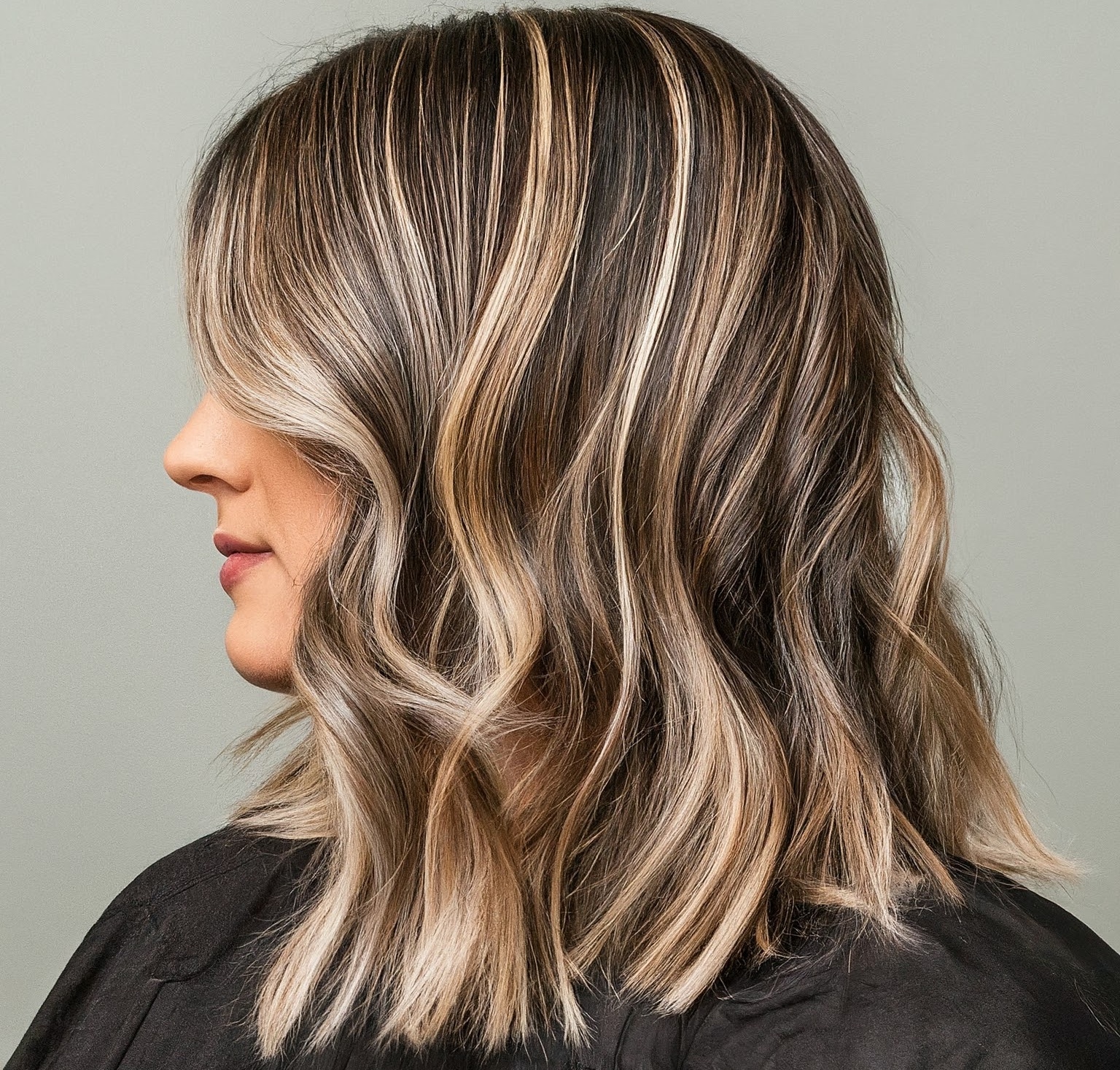Finding a hair color that turns heads without constant salon visits has never been easier. Modern highlighting techniques have transformed the way women approach color maintenance, shifting from demanding monthly touch-ups to subtle beauty that practically takes care of itself. Today’s low-maintenance methods deliver stunning results that grow out gracefully.
Traditional highlights often meant visible roots within weeks and regular color appointments that added up quickly. The newer approach focuses on seamless color placement that mimics natural hair gradients. These techniques blend perfectly with your natural shade as they grow, eliminating harsh lines and obvious regrowth patterns that once plagued highlight lovers.
The benefits extend beyond simple convenience – low-effort highlights reduce chemical exposure, save money, and protect hair health while still creating that coveted dimensional look. Let’s share here exactly which techniques deliver maximum impact with minimum maintenance, how long these gorgeous results last, and the styling secrets that keep your highlights looking salon-fresh between appointments.
- What Exactly Are Low-Maintenance Highlights?
- Which Low-Maintenance Highlight Techniques Will Give You That Wow Factor?
- How Long Will Your Low-Maintenance Highlights Stay Stunning?
- What Styling Tips Maximize Your Highlight Impact?
- Can You DIY Low-Maintenance Highlights Successfully?
- Your Low-Maintenance Highlight Journey Starts Now
- Frequently Asked Questions
What Exactly Are Low-Maintenance Highlights?
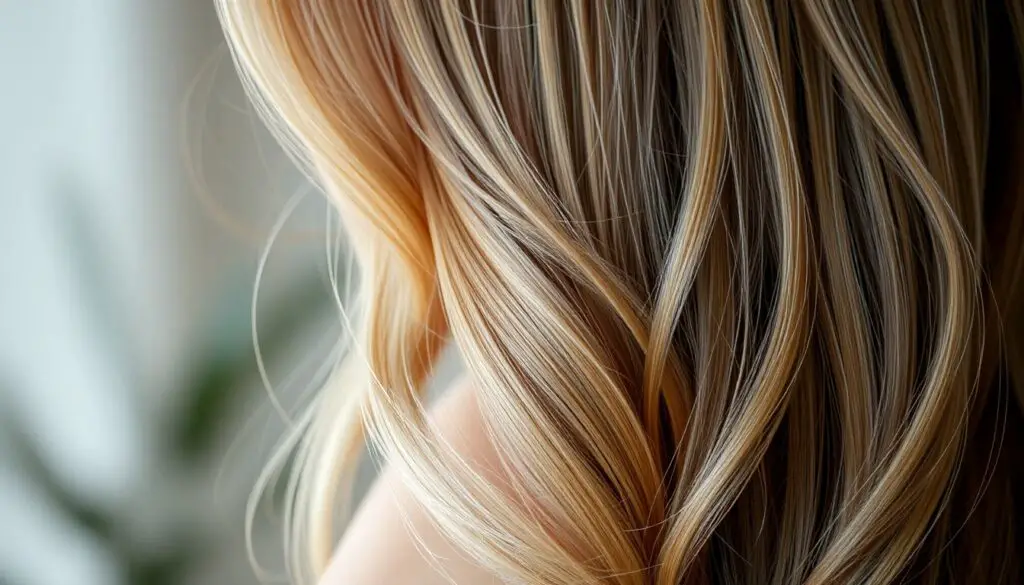
Low-maintenance highlights work differently from traditional coloring methods by creating natural-looking dimension that requires minimal upkeep. These techniques use careful placement and color selection to mimic how your hair naturally lightens with sun exposure. This approach differs from the regular, uniform application of traditional highlights.
Definition of low-maintenance highlight techniques
Traditional highlighting processes involve foil application at precise intervals, creating distinct lines throughout the hair. Low-effort methods like balayage and hand-painting deposit color only where light naturally hits your hair. This selective approach creates softer transitions that grow out gracefully instead of showing harsh demarcation lines.
The timing between applications also differs significantly. Standard highlights often need touch-ups every 4-6 weeks to maintain their appearance. Low-upkeep techniques can last 3-6 months without visible regrowth at the roots. This extended timeline reduces chemical exposure and salon costs substantially.
Key characteristics of low-upkeep color methods
What sets these techniques apart is their natural blending capability. Rather than starting color directly at the scalp, stylists position highlights slightly below the root area. This creates a shadow root effect that disguises new growth for months. The color transitions gradually from darker roots to lighter ends.
Color placement follows a mathematical precision that mimics nature’s patterns. Stylists consider factors like hair density, parting patterns, and face-framing sections. They apply lighter pieces strategically to add brightness where needed most. The result looks sun-kissed rather than obviously colored.
The science behind minimal touch-up techniques
Hair grows approximately half an inch monthly, making root coverage a constant challenge with traditional highlights. Low-maintenance methods address this by creating softer color gradients that allow for some root exposure without looking unkempt. The color melts seamlessly from darker to lighter tones.
The chemical formulation also plays a crucial role. These techniques often use demi-permanent or semi-permanent colors that fade gradually rather than maintaining sharp lines. Some stylists incorporate bond protectors that maintain hair health while minimizing damage. The gentler approach helps preserve your hair’s natural texture and strength.
How these highlights grow out naturally
The key lies in the color placement strategy. Highlights positioned away from the scalp create a transition zone that accommodates new growth. As darker roots emerge, they blend naturally with the existing color gradient. This effect resembles how beach-goers develop natural highlights from sun exposure.
Hair movement and texture also influence the grow-out process. Wavy and curly textures disguise regrowth more effectively than straight hair. The multi-dimensional aspects of these highlights distribute light differently, making root lines less noticeable during the grow-out phase.
The role of placement in reducing maintenance
Strategic color placement determines how well highlights maintain their appearance over time. Instead of highlighting every section uniformly, stylists select specific pieces that frame the face and add dimension. They often avoid the very top layer where new growth shows most prominently.
The technique includes:
- Face-framing highlights that brighten features immediately
- Hidden highlights beneath the top layer for depth
- Ribbon highlights that create seamless dimension
- Hand-painted sections that vary in thickness
This selective approach reduces the amount of hair requiring regular touch-ups while maximizing visual impact. The result requires significantly less maintenance than comprehensive highlight applications.
Which Low-Maintenance Highlight Techniques Will Give You That Wow Factor?
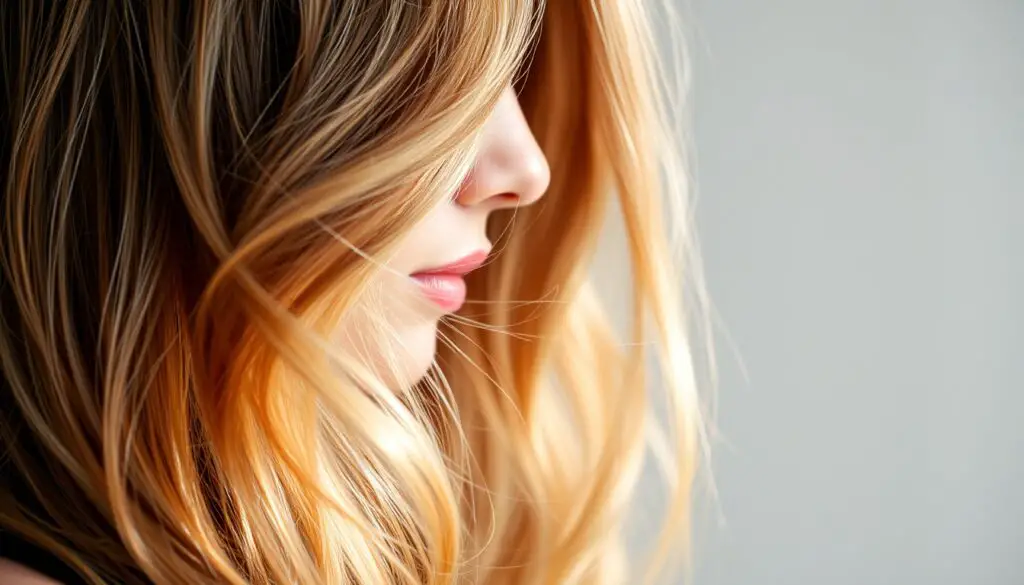
Several highlight techniques combine minimal upkeep with maximum impact. Each method offers different benefits depending on your hair texture, lifestyle, and desired look. Understanding which technique suits your needs helps you achieve that coveted glow without constant salon visits.
Balayage highlights for natural-looking dimension
This French-inspired technique involves hand-painting color directly onto sections of hair. Stylists sweep the lightener onto strands in varying thicknesses, creating a sun-kissed appearance that mimics natural lightening patterns. The painted strands dry in open air rather than foil, allowing for softer transitions.
The placement strategy follows your hair’s natural movement and fall. Stylists consider how your hair parts and flows, applying color where light would naturally hit. This thoughtful approach creates dimension that looks completely organic as it grows out.
Face-framing highlights for instant brightness
These strategic placements brighten the area around your face instantly. Stylists select pieces that border your hairline and temples, adding lightness that enhances your features. The technique requires minimal sections while delivering maximum visual impact.
The face-framing approach works exceptionally well for women seeking subtle changes without committing to full highlighting. These pieces grow out gracefully since they’re positioned away from the scalp. You’ll notice how these highlights catch light and brighten your complexion immediately.
Ribbon highlights for subtle radiance
This technique creates thin, uniform streaks throughout your hair that resemble delicate ribbons. Stylists weave these highlights through various layers, adding depth without overwhelming your natural color. The uniform width creates a polished appearance that requires fewer touch-ups.
What makes ribbon highlights special is their versatility. They work beautifully on both straight and textured hair, creating movement and interest. The thin application means less processing time and reduced chemical exposure while still delivering noticeable results.
Micro-highlights for delicate enhancement
Think of these as miniature versions of traditional highlights. Stylists use ultra-thin sections to create thousands of tiny lightened strands throughout your hair. This technique produces remarkably natural results that mimic how hair naturally lightens over time.
The delicate nature of these highlights means they blend seamlessly as they grow out. The numerous small sections create a mesh of color that appears multi-dimensional from every angle. This method particularly suits women wanting to brighten their hair gradually without dramatic changes.
Root shadow highlights for seamless grow-out
This innovative technique starts the lightening process several inches below the scalp, creating a natural shadow at the roots. Stylists apply darker tones at the base, gradually transitioning to lighter shades through the mid-lengths and ends. This intentional gradient disguises new growth for months.
The shadow root technique addresses everyone’s biggest maintenance concern – visible regrowth. By starting the highlights lower on the strand, your natural hair color blends perfectly with the colored sections as new hair emerges. This approach significantly extends the time between salon visits.
Choosing between these techniques depends on several factors worth considering:
- Hair density and texture
- Natural color level
- Lifestyle demands
- Desired maintenance schedule
- Budget considerations
Each technique offers its own balance of impact versus maintenance needs. Consider consulting with a colorist experienced in these methods to determine which approach aligns best with your hair goals and daily routine.
How Long Will Your Low-Maintenance Highlights Stay Stunning?
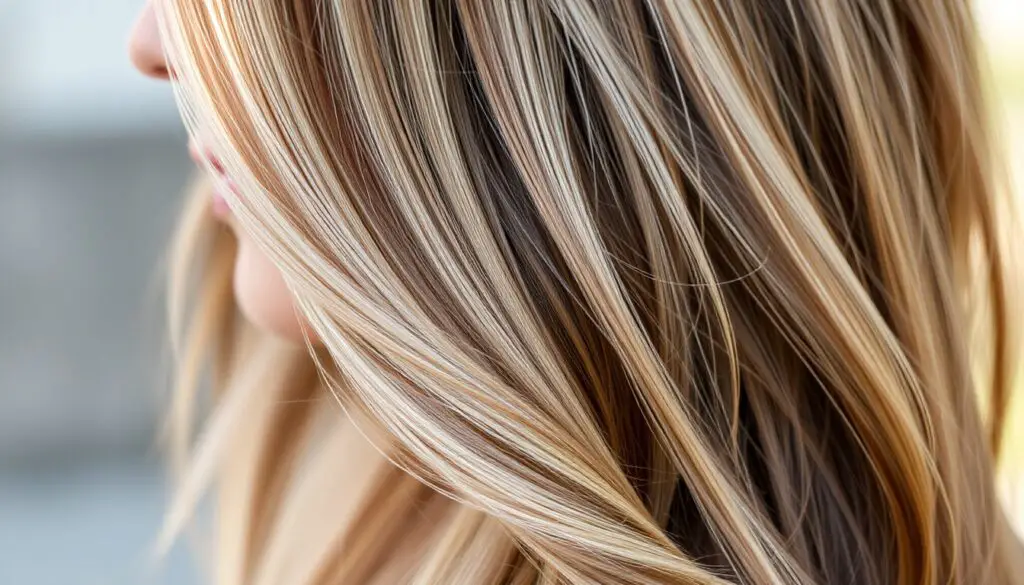
Your highlights’ longevity depends on multiple factors including technique, natural hair growth, and maintenance habits. Different highlighting methods offer varying durations before requiring touch-ups. Understanding these timelines helps you plan your color journey effectively.
Typical longevity of different highlight techniques
Balayage highlights generally maintain their appeal for 12-16 weeks due to their hand-painted nature that creates natural-looking transitions. The grow-out phase appears intentional rather than obvious. Traditional foil highlights typically need refreshing every 6-8 weeks as they show distinct regrowth lines much sooner.
Face-framing pieces can last 8-12 weeks since they’re positioned away from your crown where growth appears most obvious. Root shadow techniques extend to 16-20 weeks because the darker base camouflages new growth seamlessly. Ribbon highlights fall between these ranges, lasting approximately 10-14 weeks depending on placement depth.
Signs it’s time for a refresh
Noticeable regrowth bands appear most clearly along your part line and temples. These areas typically show contrast first because the hair grows most visibly here. You’ll notice the bands become approximately half an inch wide before requiring attention.
Fading color intensity signals another refresh moment. Sun exposure, washing frequency, and heat styling all contribute to color fade. Your highlights might lose their vibrancy and appear brassy or dull before the roots become problematic.
Extending the life of your highlights
Your daily habits significantly influence how long your color stays fresh. Using purple or blue shampoo weekly prevents unwanted warm tones from developing. These products neutralize the yellow and orange tones that naturally emerge as highlights fade.
Heat protection becomes critical for maintaining color integrity. Apply thermal protectants before using hot tools to prevent accelerated fading and damage. Air-drying whenever possible reduces unnecessary stress on highlighted strands, helping them maintain their brightness longer.
Seasonal considerations for highlight maintenance
Summer conditions present specific challenges for highlighted hair. Chlorine from pools strips color faster than regular water exposure. The sun’s UV rays also accelerate fading and can turn blonde tones brassy quickly.
Winter weather brings different concerns with indoor heating systems that create dry conditions. Your highlights might appear more porous and absorb moisture from the environment, leading to color shifts. Adjusting your maintenance routine seasonally helps combat these environmental factors:
Summer Protection: Wear hats during peak sun hours to shield your color
Winter Care: Use leave-in conditioners to combat static and dryness
Spring Renewal: Consider refreshing techniques to brighten after winter’s dullness
Fall Transition: Add deeper lowlights for a richer, more dimensional look
The role of hair health in highlight longevity
Healthy hair holds color more effectively than damaged strands. The cuticle integrity affects how well pigment molecules stay locked inside each strand. Pre-highlighting treatments that strengthen hair bonds can extend your color’s lifespan significantly.
Protein-rich hair masks applied weekly help maintain structural integrity in highlighted sections. These treatments replenish what chemicals deplete during the lightening process. Well-maintained highlights not only last longer but also appear more vibrant throughout their lifecycle.
Regular trims prevent split ends from traveling up highlighted strands, which can cause color to appear patchy. Your stylist can recommend trimming schedules based on your hair’s specific needs and highlight placement pattern.
What Styling Tips Maximize Your Highlight Impact?
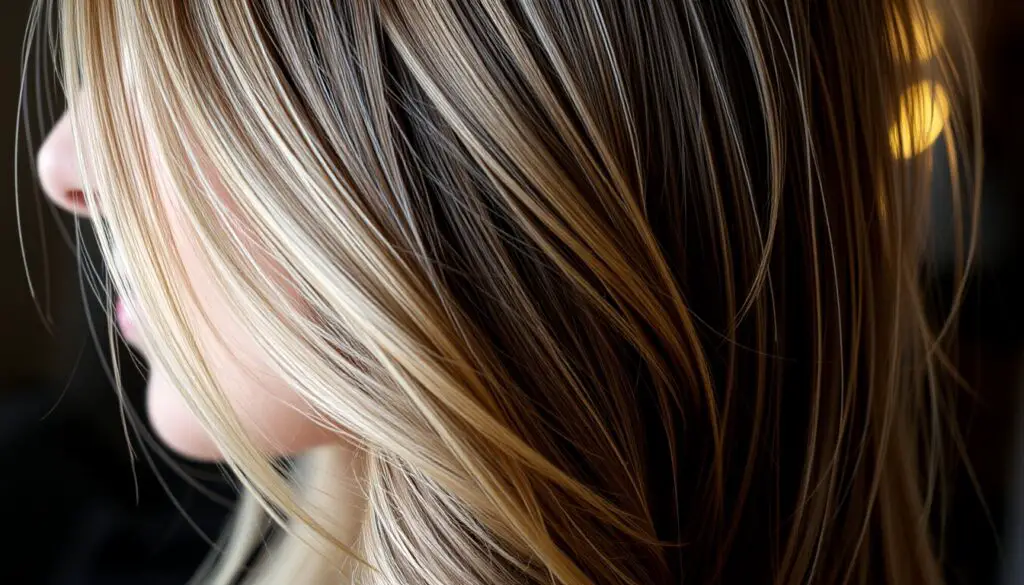
Proper styling techniques can transform your highlights from nice to absolutely stunning. The right approach showcases dimension while keeping your color vibrant and healthy. Smart product choices and styling methods make a significant difference in how your highlights catch light and frame your features.
Product recommendations for highlighted hair
Silver and purple shampoos become essential tools for maintaining blonde and light highlights. These color-correcting products neutralize brassy tones that naturally develop between salon visits. Use them once or twice weekly to keep your highlights looking fresh and salon-quality.
Leave-in treatments designed for color-treated hair offer daily protection. Look for products containing UV filters and antioxidants that shield your highlights from environmental damage. Lightweight serums work best for fine hair, while thicker creams suit coarse textures that need extra moisture.
Techniques to enhance highlight visibility
Bouncy waves naturally show off dimensional color by creating movement that catches light differently. Use a large-barrel curling iron or hot rollers to create loose waves that shift and separate strands. This movement reveals the contrast between your highlighted and natural sections.
Strategic parting changes every few days help prevent highlights from appearing flat in one area. Side parts naturally frame your face with lighter pieces, while center parts create symmetry. Switching between parting positions ensures even wear distribution across your highlighted sections.
Hair flipping techniques during styling can dramatically increase highlight visibility. Run your fingers through your hair while blow-drying to create lift at the roots. This motion separates strands and allows light to hit more surface area, making highlights appear brighter and more defined.
Heat styling considerations for highlighted strands
Temperature control prevents excessive damage to chemically processed hair. Never exceed 350°F for highlighted hair, as higher temperatures can cause dryness and color fading. Digital tools with precise temperature settings help you maintain control over heat exposure.
Even heat distribution matters significantly with highlights. Use wide-tooth attachments on blow dryers to prevent concentrated heat on specific sections. When using flat irons or curling tools, work with smaller sections to ensure even heat application across all strands.
Air-dry methods that showcase dimension
Scrunch-drying creates natural texture that enhances highlight placement. Apply mousse or styling cream to damp hair and gently scrunch upward to encourage wave formation. This method works particularly well for wavy or curly textures, creating separation that highlights dimensional color.
Twist-and-pin techniques offer an alternative for straight hair types. Section damp hair and twist loosely before pinning to your scalp. Remove pins once hair is mostly dry for beautiful waves that emphasize highlight placement throughout your hair.
Night routines that protect your investment
Silk or satin pillowcases reduce friction that can lead to color fading and breakage. These smooth fabrics prevent highlighted strands from rubbing against rough cotton, which can strip moisture and damage chemically treated hair. The investment pays off in longer-lasting color vibrancy.
Weekly deep conditioning masks specifically formulated for color-treated hair restore moisture and proteins depleted during highlighting. Apply these treatments before bed, covering with a shower cap to allow maximum penetration. Rinse thoroughly in the morning for revitalized, glossy highlights.
Your nighttime routine creates the foundation for beautiful daytime styling. Simple changes like using proper bedding materials and scheduled treatments maintain the wow factor in your highlights between salon visits. These practices complement your styling efforts by preserving the integrity of your color investment.
Can You DIY Low-Maintenance Highlights Successfully?
The allure of DIY highlights tempts many women seeking to save money and time. At-home kits have improved significantly, offering various lightening formulations and application tools. However, the skill level required for natural-looking results shouldn’t be underestimated.
Professional vs. at-home highlight risks
Professional stylists train for months to understand hair chemistry, color theory, and proper lightening techniques. They assess your hair’s condition, porosity, and previous treatments before selecting appropriate products. Home highlight kits use one-size-fits-all formulations that may react unpredictably with your specific hair type.
Chemical burns, uneven color distribution, and orange brassy tones represent common DIY disasters. Over-processing can lead to severe breakage, especially on previously colored hair. Professional colorists monitor development time precisely, adjusting based on your hair’s response during the process.
When to choose salon application
Virgin hair lightens more predictably than previously treated strands. If you’ve never colored your hair, salon application becomes less critical though still recommended for optimal results. However, hair with existing color, especially darker shades or previous highlights, demands professional expertise.
Complex highlight patterns like balayage or multi-dimensional color absolutely require professional skill. These techniques involve strategic placement and varying processing times across different sections. Attempting these methods at home often results in patchy, unnatural-looking color.
Tools needed for home highlighting
Standard at-home kits include mixing bowls, applicator brushes, and lightening powder or cream. Most packages provide caps with holes for pull-through highlighting or basic foil sheets. Additional items that increase success chances include sectioning clips, a tail comb for precise parting, and gloves rated for chemical use.
Professional-grade tools available for purchase include highlighting boards that provide even tension and placement. Specialty combs with measurement markings help create uniform sections. However, owning proper tools doesn’t guarantee proper technique without adequate training.
Common DIY mistakes to avoid
Several critical errors plague home highlighting attempts. Here are the most frequent mishaps to watch for:
Spacing Issues: Placing highlights too close together creates a block of solid color
Processing Times: Leaving lightener on too long can cause irreversible damage
Placement Errors: Highlighting the wrong sections leaves obvious demarcation lines
Overlapping Color: Applying new lightener over previously highlighted sections causes breakage
Temperature Control: Processing in cold environments prevents proper lift
Maintaining professional quality at home
If you proceed with DIY highlighting despite the risks, start conservatively. Choose face-framing pieces or pull-through cap methods for your first attempt. These techniques offer more control than freehand application and create subtle results.
Test strands hide inside the bottom layer where mistakes are less visible. Apply lightener to a small section first, checking every 10 minutes to gauge processing speed. Document your timing and observations for future reference.
Quality maintenance products become even more crucial with home-processed hair. Invest in professional-grade purple shampoo, deep conditioning treatments, and heat protectants. These products help minimize damage and extend the life of your DIY highlights.
Success stories exist for home highlighting, particularly for simple techniques on healthy, virgin hair. Women with fine, light hair often achieve satisfactory results with highlight caps or touch-up kits designed for root maintenance. Nevertheless, consultation with a colorist remains valuable even if you ultimately choose the DIY route.
Your Low-Maintenance Highlight Journey Starts Now
Low-maintenance highlights offer the perfect solution for busy women wanting gorgeous hair without constant salon visits. From balayage’s natural sun-kissed effect to ribbon highlights’ polished radiance, these techniques deliver stunning results that grow out beautifully. The key lies in choosing the right method for your lifestyle and hair type, then supporting it with proper styling products and techniques.
Success comes from understanding which highlights work best for your needs and committing to simple maintenance routines. Whether you opt for face-framing brightness or micro-highlights for natural enhancement, proper care extends their lifespan considerably. While professional application yields superior results, informed DIY attempts can work for simple techniques on virgin hair. Your journey to effortless, beautiful highlights begins with making the right choice for your specific hair goals and lifestyle demands.
Frequently Asked Questions
Q: How long do low-maintenance highlights typically last before needing a touch-up?
A: Low-maintenance highlights can last 12-16 weeks for balayage, 8-12 weeks for face-framing highlights, and up to 20 weeks for root shadow techniques. Traditional foil highlights require touch-ups every 6-8 weeks in comparison.
Q: What’s the difference between balayage and traditional highlighting?
A: Balayage involves hand-painting color directly onto hair strands in open air, creating natural-looking dimension that grows out seamlessly. Traditional highlighting uses foil or caps to create uniform sections with distinct lines that show obvious regrowth.
Q: Is it worth trying to DIY low-maintenance highlights?
A: DIY highlights work best for simple techniques on virgin hair, particularly using highlighting caps or touch-up kits. Complex patterns like balayage or multi-dimensional color require professional expertise to avoid uneven color, damage, or brassy tones.
Q: How often should I use purple shampoo on my highlights?
A: Use purple shampoo once or twice weekly to neutralize brassy tones in blonde highlights. Overuse can deposit too much purple pigment, so stick to the recommended frequency based on your highlight intensity.
Q: What styling methods best showcase highlight dimension?
A: Loose waves created with large-barrel curling irons or hot rollers naturally separate strands to reveal highlighted sections. Strategic parting changes and scrunching damp hair with mousse also enhance highlight visibility.
Q: Which highlights require the least maintenance?
A: Root shadow highlights offer the most minimal maintenance, lasting 16-20 weeks because they start several inches below the scalp. Face-framing highlights and balayage are also excellent low-maintenance options.
Q: Can I air-dry highlighted hair without losing dimension?
A: Yes, use scrunch-drying with mousse for natural texture that separates highlighted pieces. For straight hair, try twist-and-pin methods on damp hair, removing pins when mostly dry for beautiful waves.
Q: What temperature is safe for heat styling highlighted hair?
A: Never exceed 350°F on highlighted hair. Use tools with precise temperature controls and heat protectant products to prevent damage and color fading.
Q: When should I consider professional highlighting instead of DIY?
A: Choose professional application for previously colored hair, complex patterns like balayage, or when lightening dark hair. Professionals can assess your hair’s condition and adjust techniques for optimal results.

